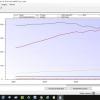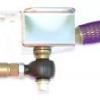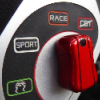Its not a monster power car, and never will be, so no problems with general fuel delivery, just left handers.
Ive read about the uprated fuel tanks, and most seem to talk about what a ball ache the tanks are to change, cut access holes in bulkheads and with the long range tanks brimming can be problematic.
Had though about heat soak into the small tank if engine mounted, however when on track the draw through may be sufficient that heat build up would be minimal. What temp does fuel need to get to to cause issues?
Had planned on high spec hoses, connections etc (aeroquip) as didn't want the stuff spraying round the engine bay. However, is this any more risky than standard fuel lines if they leak? As the requirement is to counter he surge in the tank, rather than up the pressure, perhaps a standard pressure pump would be a better idea.
Splitfire, does your re-furbed pump eliminate the surge, or just produce a higher pressure?
Thanks all for comments. Plenty to think about. Particularly the safety of a rear mounted tank.
Hi
Tank
Starting with the tank, there is no reason why it should be any more difficult to fit an aftermarket tank than an OE one, it just needs to be designed correctly, we have spent some time with Dan working through the current issues with aftermarket tanks and looking to make a new design with a larger capacity but not so large it causes other problems. You certainly will not have to butcher the car.
The trap works much better and the fuel sender is in the tank not the trap (yes it is accessible should it fail) 
Leaks
Any joint is a potential leak, assuming any pipework is of the correct specification this part of the install should not be a problem however there are plenty of threads on SELOC about split pipes including sheathed ones. The biggest problem is lack of knowledge, with owners being ill advised that they need to use large bore pipes "because of the extra power the OE pipes cannot get enough fuel through" this is complete rubbish and the OE pipes can supply any engine you can fit in the Elise/VX series cars with little drag, a 500 bhp engine losses in fuel pipe drag is only about 2%, this doesn't mean you are down 2% on power it just means 2% of the pumps output is lost in efficiency, the pump should easily supply more than is required. As an example we always lower our output figures by 10% minimum to allow for such losses and long term wear and tear.
Once you start using large bore pipes you are creating your own problem as the force on the pipe wall is directly related to the internal surface area, worse, as the fuel is always moving due to the return there is some reduction in pressure due to the higher flow of the smaller bore pipe but I can't be arsed to calculate this at the moment 
To date I have never seen a split OE pipe, and as this specification pipe is used just about on every vehicle made clearly it is more than capable and doesn't seen to deteriorate either. This is helped by the small bore which reduces wall pressure which in turn restricts expansion and fatigue on the material.
Fuel heating
Problems are most common on swirl pot installations, this is not surprising as you have two pumps heating the fuel (pumps use fuel to both cool and lubricate) and the return fuel is stored in the engine bay initially, it works better on cars with a cool airflow over the swirl pot.
Vaporisation is directly linked to pressure and temperature.
Pumps
When you say surge you mean starvation of course, the situation is quite simple really, you either have enough fuel stored to keep the engine running or you don't! 
Storage is primarily the tank itself, secondary storage is the canister which is part of and one of the functions of the pump unit.
Left hand corners with the G and fuel level considered means you can quickly reach a situation where the fuel in the tank is not available to the pump so you are relying on the pump canister.
This works fine when standard engines are considered as consumption is such that the 200cc or so stored in the canister is enough for 15 seconds or so without access to the tank fuel, clearly as you start to increase consumption this time will fall, eventually to the extent the engine will stall because of starvation.
You now have only one option but several methods, you need to store more fuel so the options are an external surge tank, a trapped tank (internal surge tank) a better refill system for the canister if this is the problem i.e canister is not full before starting the left turn or a new tank design. Clearly the last is a function of the vehicle design so that is not really an option though it you stood the OE tank on one end it would work perfectly down to the last few drips! But it may look a bit odd sticking up through the engine cover.
The new pump units have a larger capacity and also a very quick refill system even a full power they still supply enough excess fuel to recharge the canister in about 4-5 seconds, quicker with higher pressure rail pressures, note this does not include return fuel.
If your consumption is still too high for the fuel available then this leaves you with the two captive fuel options, internal or external.
Clearly the internal is a far superior option as the main pump remains in the coolant hence it is protected and also MUCH quieter.
The trap is recharged almost instantaneously by surge in a right hander so much quicker than an external surge tank and you do not need any pumps or pipework to carry this operation out. The fuel also remains in a cool part of the vehicle and is fully mixed with tank fuel so you see no local heating as with an external option.
It has to be safer as there are no pipes/pumps/unions/power cables at all to service the stored fuel.
They are also much larger, it is easy to trap 6-10 litres internally and still keep the horizontal surface area of the trap to a minimum, i.e fuel is stored in height not width. Most external surge pots are small by comparison, this becomes more of a heating issue as the volume to surface area is smaller also.
In answer to your question power wise the HP pumps we do are for cars up to about 400bhp NA and 360 SC both at OE pressures, these will fall if you increase rail and/or boost. The VHP conversions we do can support anything in a VX.
Canister storage wise it depends on several factors including the time spent with the canister fuel alone and the specific consumption of the engine being the main ones, if you have a 500bhp car and want to track seriously you will need additional storage for sure.
For a road car you can use the pumps without any additional storage.
For anything in between ............
So the answer is both pump unit options supply a much higher output and the new units both store more fuel and refill quicker.
The OE units also fill quicker as we adjust the eductor pump to match the pump selected but you are still stuck with 200cc capacity.
What power are you hoping to make??

Gaz





















